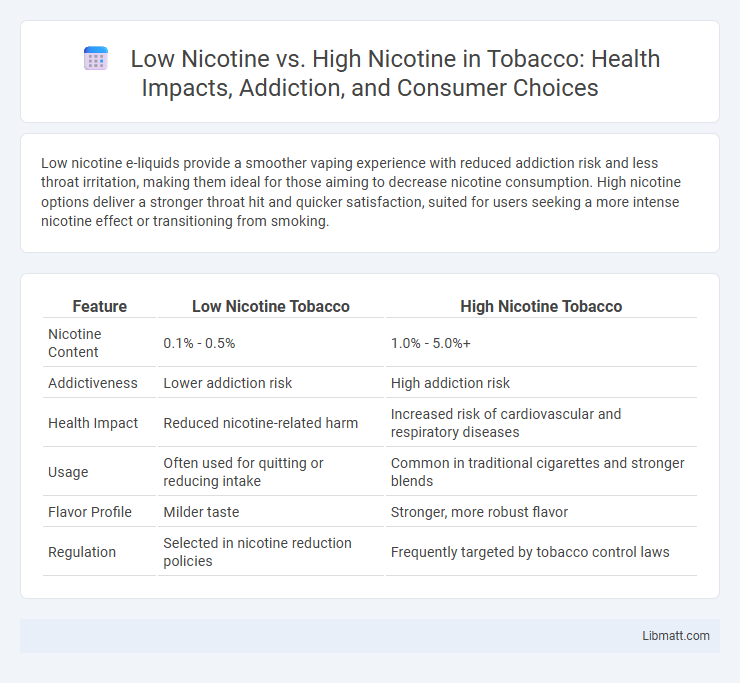Low nicotine e-liquids provide a smoother vaping experience with reduced addiction risk and less throat irritation, making them ideal for those aiming to decrease nicotine consumption. High nicotine options deliver a stronger throat hit and quicker satisfaction, suited for users seeking a more intense nicotine effect or transitioning from smoking.
Table of Comparison
| Feature | Low Nicotine Tobacco | High Nicotine Tobacco |
|---|---|---|
| Nicotine Content | 0.1% - 0.5% | 1.0% - 5.0%+ |
| Addictiveness | Lower addiction risk | High addiction risk |
| Health Impact | Reduced nicotine-related harm | Increased risk of cardiovascular and respiratory diseases |
| Usage | Often used for quitting or reducing intake | Common in traditional cigarettes and stronger blends |
| Flavor Profile | Milder taste | Stronger, more robust flavor |
| Regulation | Selected in nicotine reduction policies | Frequently targeted by tobacco control laws |
Introduction to Nicotine Levels
Nicotine levels in tobacco products vary widely, influencing both the intensity of the experience and potential health impacts. Low nicotine products typically contain 0.5-6 mg per serving, reducing addiction risk and easing the transition for those trying to quit. High nicotine options, often exceeding 12 mg per serving, deliver a stronger stimulant effect but increase dependence and health concerns.
Defining Low vs High Nicotine
Low nicotine products contain nicotine concentrations typically under 6 mg/mL, often preferred by users seeking reduced dependency or milder effects. High nicotine products exceed 12 mg/mL, delivering stronger nicotine hits and more intense stimulation, commonly chosen by heavy smokers or users needing rapid nicotine satisfaction. The distinction between low and high nicotine is crucial for managing intake levels, addiction potential, and overall user experience in nicotine consumption.
How Nicotine Strength Affects the Body
Low nicotine levels provide a milder stimulant effect, resulting in reduced dopamine release and lower addiction potential, which may help minimize withdrawal symptoms. High nicotine concentrations significantly increase heart rate and blood pressure, stimulating the central nervous system more intensely and leading to stronger cravings and quicker dependency development. The body's response varies, with high nicotine often causing increased alertness and potential adverse cardiovascular effects, while low nicotine offers a gentler impact on neurotransmitter balance and overall physiological stress.
Flavor and Throat Hit: Impact of Nicotine Concentration
Low nicotine e-liquids preserve the full spectrum of flavors, offering a smoother and richer taste experience, while high nicotine concentrations tend to mute flavor intensity due to the stronger throat hit. High nicotine levels create a pronounced throat hit that can feel harsh or spicy, often preferred by smokers transitioning to vaping for nicotine satisfaction. Your choice between low and high nicotine impacts both flavor complexity and throat sensation, influencing overall vaping enjoyment.
Addiction Risks: Low versus High Nicotine
Low nicotine products reduce the risk of addiction by delivering smaller doses of nicotine, minimizing dependence potential compared to high nicotine products. High nicotine products increase the likelihood of stronger addiction due to rapid and intense nicotine delivery, activating brain reward pathways more powerfully. Understanding the addiction risks tied to nicotine concentration is crucial for making informed decisions in smoking cessation and harm reduction strategies.
Health Implications of Different Nicotine Levels
Low nicotine levels reduce the risk of addiction and lower exposure to harmful substances, contributing to better cardiovascular and respiratory health outcomes. High nicotine intake increases the probability of developing dependence, raising the risk of heart disease, hypertension, and adverse neurological effects. Research shows that managing nicotine dosage is crucial for minimizing long-term health complications associated with tobacco and vaping products.
Choosing the Right Nicotine Strength for You
Choosing the right nicotine strength depends on your smoking habits and tolerance; low nicotine levels (1-3 mg) are ideal for light smokers or those seeking to reduce nicotine intake gradually. High nicotine strengths (12-24 mg) suit heavy smokers or those needing a stronger nicotine hit to manage cravings effectively. Selecting the appropriate nicotine level ensures a satisfying experience while minimizing withdrawal symptoms and supporting your quitting goals.
Transitioning Between Nicotine Levels
Transitioning between low nicotine and high nicotine levels requires careful adjustment to avoid withdrawal symptoms and maintain satisfaction. Gradually increasing nicotine intake can prevent cravings associated with low levels, while stepping down from high nicotine reduces dependency and health risks. Monitoring consumption patterns and selecting appropriate nicotine strengths supports smoother transitions and personalized nicotine management.
Popular Products: Low Nicotine vs High Nicotine Options
Popular low nicotine products include vape liquids with nicotine strengths ranging from 0 mg to 6 mg, catering to users seeking mild nicotine intake or gradual reduction. High nicotine options often feature strengths from 12 mg up to 50 mg, commonly found in nicotine salt e-liquids designed for rapid absorption and stronger satisfaction. Your choice between low and high nicotine products depends on your smoking habits and desired nicotine impact.
Expert Recommendations on Nicotine Consumption
Experts recommend limiting nicotine intake due to its addictive properties and potential health risks, emphasizing low nicotine consumption as a safer alternative. Studies indicate that lower nicotine levels reduce dependence and facilitate cessation efforts compared to high nicotine products, which can increase addiction severity. Regulatory bodies like the FDA advocate for nicotine caps in tobacco products to minimize public health impacts.
Low nicotine vs High nicotine Infographic

 libmatt.com
libmatt.com